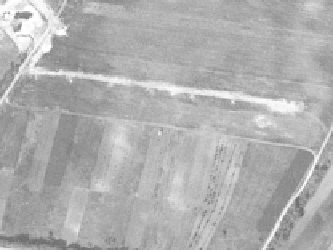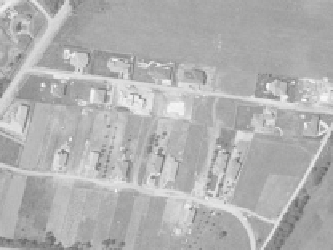Information Technology Reference
In-Depth Information
(a) Older image
(b) Newer image
Fig. 2.
Original image pairs
these kind of images, changes can mean the appearance of new man-made ob-
jects, (like buildings or streets), or natural, environmental variatons. As image
pairs may be taken with large intervals of time, the area may change largely. In
our case the pieces of the image pairs was taken in 2000 and 2005 ( Figure 2). The
registration was performed manually by Hungarian Institute of Geodesy, Car-
tography and Remote Sensing, therefore we worked on image pairs representing
exactly the same area.
In our work we mainly focus on newly built objects (buildings, pools, etc. ).
There are many diculties when detecting such objects in airborne images. The
illumination and weather circumstances may vary, resulting different colour, con-
trast and shadow conditions. The urban area might be imaged from different point
of view. Buildings can be hidden by other structures, like trees, shadows or other
buildings. These objects are quite various, which also makes the detection tough.
To overcome a part of the aformentioned diculties, our idea was to use the
difference of the image pairs. As we are searching for newly built objects, we
need to find buildups, that only exist on the newer image, therefore having large
effect both in the difference image and the newer image.
First, we examined the usability of intensity based (Figure 3(a)) and edge
based difference map (Figure 3(b)).
Intensity based and edge based difference maps are calculated as follows:
I
mod
diff
I
mod
old
I
mod
=
|
−
new
|
(2)
where
I
old
and
I
new
means the older and newer pieces of the image pairs respec-
tively. The upper index mod refers to the basis of the modification: for example
in case of the edginess
I
mod
new
=
I
edge
new
=edge(
I
new
).
When searching for keypoint candidates, we call for Harris detector. As writ-
ten before, the new objects have high effects both on the new and difference,
therefore we search for such keypoints that accomplish the next two criterias
simultaneously:
1.
R
(
I
mod
diff
)
>
1
2.
R
(
I
mod
new
)
>
2




Search WWH ::

Custom Search